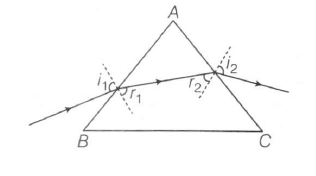Answer:
Option A,B,C
Explanation:
The minimum deviation produced by a prism
$\delta_{m}=2i-A=A$
$\therefore $ $i_{1}=i_{2}=A$ and $r_{1}=r_{2}=\frac{A}{2}$
$\therefore $ $r_{1}=\frac{i_{1}}{2}$
Now using Snell's law
$\sin A= \mu \sin\frac{A}{2}$
$\Rightarrow \mu = 2\cos (A/2)$

For this prism when the emergent ray at the second surface is tangential to the surface
$i_{2}=\frac{\pi}{2}$
$\therefore $ $r_{2}=\theta_{c}$
$\therefore $ $r_{1}=A-\theta_{c}$
so, $\sin i_{1}=\mu \sin(A-\theta_{c})$
so,
$i_{1}= \sin^{-1}[\sin A\sqrt{4\cos^{2}\frac{A}{2}-1}-cos A]$
For minimum deviation through the isosceles prism, the ray inside the prism is parallel to the base of the prism $\angle B=\angle C$
But it is not necessarily parallel to the base it. $\angle A=\angle B$ or $\angle A=\angle C$